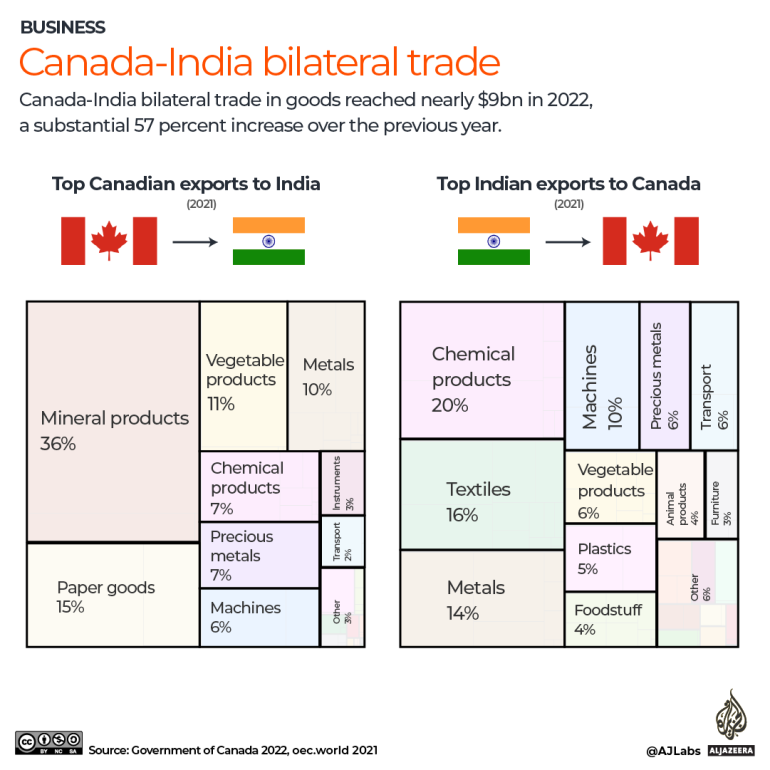What is the Khalistan movement? How is it linked to India-Canada tensions?
As row over killing of Sikh separatist Hardeep Singh Nijjar continues, Al Jazeera visually explains the history of the movement.
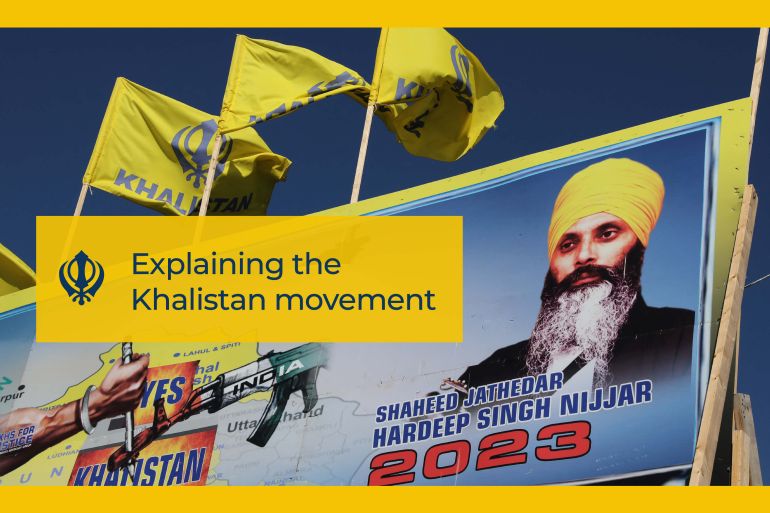
A row between India and Canada surrounding Sikh independence, commonly referred to as the Khalistan movement, continues to cause tensions.
Last week, Canadian Prime Minister Justin Trudeau accused India of playing a role in the killing of Sikh separatist leader Hardeep Singh Nijjar, who was shot dead in June in British Columbia state.
Keep reading
list of 4 itemsSatellite images reveal Israeli destruction of hospitals in Gaza
Mapping Israel-Lebanon cross-border attacks
Eid Mubarak: Hear greetings in different languages
The Indian government has dismissed Ottawa’s allegations as “absurd”.
In this infographic series, Al Jazeera takes a look at the movement and its origins.
What is the Khalistan movement?
Khalistan is the name of the proposed state envisioned by some Sikhs, incorporating the Indian state of Punjab as well as other Punjabi-speaking areas of northern India to establish a Sikh nation.
The ethno-religious liberation movement gained traction in the 1970s and early 80s in India. It later died down but has developed momentum among the Sikh diaspora in recent years.

What would Khalistan look like?
There is division among supporters of Khalistan on the boundaries of a sovereign Sikh state, but most agree that it would encompass the state of Punjab in India.
The historical Punjab region is located in the northern part of the Indian subcontinent and includes modern-day eastern Pakistan and northwestern India. In India, it includes cities like Ludhiana, Amritsar, Chandigarh and Jalandhar; and Lahore, Faisalabad, Nankana Sahib, Rawalpindi and Multan in Pakistan.

Some Khalistan supporters have called for the incorporation of the Pakistani side of Punjab, while other groups argue that some areas of Haryana and Himachal Pradesh, states surrounding India’s Punjab, should also form part of the proposed nation.
How many Sikhs are there in India today?
According to the 2011 Indian census, the last when it was held, there are about 20.8 million Sikhs, making up 1.7 percent of the country’s population.
The majority of Sikhs, about 16 million at the time of the census, live in the northern state of Punjab where they make up about 58 percent of the state’s population.
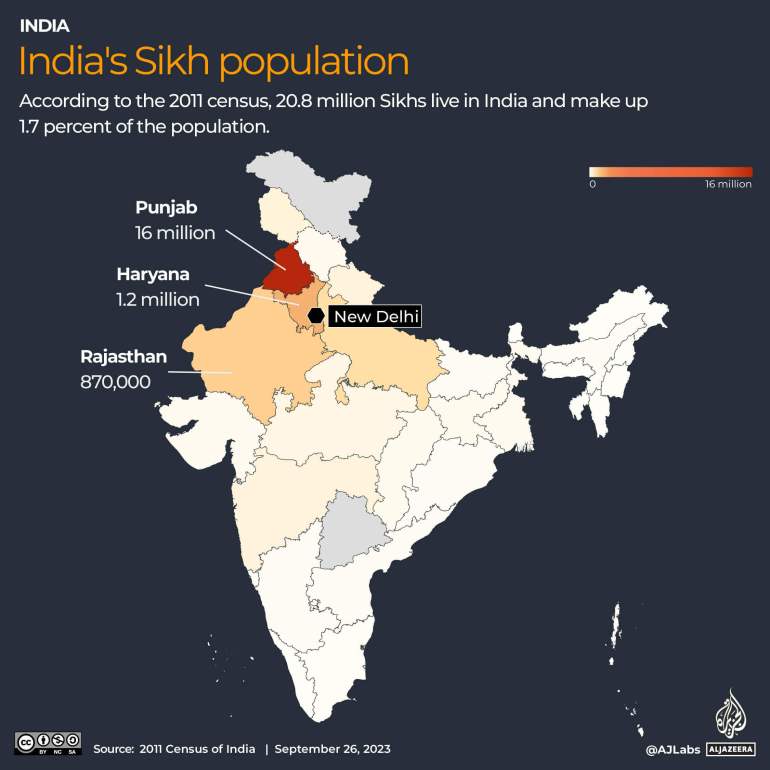
What is the history of the Khalistan movement?
The notion of Khalistan is rooted in Sikhism, a faith that arose during the 15th century when northern India was under Mughal rule.
Led by Guru Gobind Singh, the faith was recast in 1699 under Khalsa, a word derived from Arabic meaning pure, to incorporate a political vision to protect Sikhs and other religions from religious persecution and to establish Sikh rule.
Following the partition of the Indian subcontinent in 1947, the Punjabi Suba movement emerged which called for the establishment of a Punjabi-speaking autonomous Sikh state.
In 1952, the then-Indian Prime Minister Jawaharlal Nehru declared he would suppress the demand for a Punjabi-speaking state, leading to divisions between Sikhs and Hindus.
Ultimately, in 1966, the state of Punjab was created with Chandigarh as its capital.
In the 1970s and 80s, following for the Khalistan movement re-emerged among Sikhs in India and the diaspora. Spurred by the Sikh rebel leader, Jarnail Singh Bhindranwale, the movement became an armed rebellion.
The rebellion lasted more than a decade and was suppressed by a violent crackdown by the Indian government, in which thousands of people were killed, including prominent Sikh leaders.
In 1984, Indian forces stormed the Golden Temple, Sikhism’s holiest site, in Amritsar, Punjab to flush out separatists who had taken refuge there. The operation killed about 400 people, according to official Indian government figures, but Sikh groups say thousands were killed.

The dead included Bhindranwale, whom the Indian government accused of leading the armed rebellion.
On October 31, 1984, then-Prime Minister Indira Gandhi, who had ordered the raid on the temple, was assassinated by two of her Sikh bodyguards.
Her death triggered a series of anti-Sikh riots, in which Hindu mobs went from house to house across northern India, particularly New Delhi, pulling Sikhs from their homes, hacking many to death and burning others alive.
The following year, on June 23, 1985, a bomb exploded on Air India Flight 182 over the Atlantic Ocean, killing all 329 people on board.
An investigation into the bombing revealed that it was orchestrated by Canadian-based Sikh fighters as revenge for the Golden Temple operation.
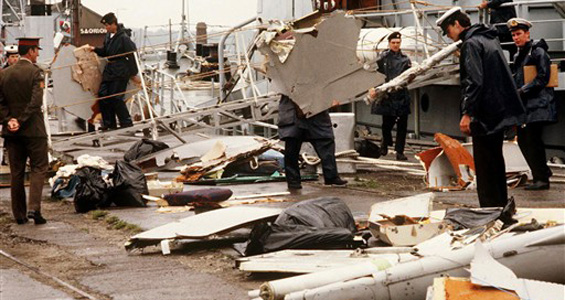
Where does the Khalistan movement stand today?
Indian Prime Minister Narendra Modi’s government has intensified the pursuit of Sikh separatists and arrested dozens of leaders from various outfits allegedly linked to the movement.
Hartosh Bal, executive editor of The Caravan magazine in India, told Al Jazeera the Sikh separatist movement has been non-existent for decades in India.
“The Khalistan movement has a long history, and during the 1980s, there was a violent military movement on Indian soil. But ever since – at least in India, in the state of Punjab, where the Sikhs are the majority – the Khalistan movement has been virtually non-existent, enjoys no political support and goes up and down depending on the attention the Indian government pays to it,” Bal said.
“But the Modi government has consistently hyped up the Khalistani threat to India. I think, again, because it suits them domestically to talk about security threats to the Indian nation, rather than the actual measure of threat on the ground from the movement.”
The Khalistan movement has seen some support in diaspora Sikh communities, particularly in Canada, the United Kingdom, the United States and Australia.
Where are the largest Sikh diaspora populations?
There are an estimated 26 million Sikhs around the world, according to the London School of Economics (LSE). Canada has the largest Sikh community outside India, with about 770,000 people having reported their religion as Sikh in the 2021 census.
According to the 2021 census in Egland and Wales, about 524,000 Sikhs are living in both countries. About 210,000 live in Australia, according to its 2021 census.
While the US census does not record religion, it is estimated that there are anywhere between 200,000 to 500,000 Sikhs in the country.
In the past three years, Sikhs for Justice (SFJ) has organised unofficial referendums on the establishment of Khalistan in a number of countries. In Australia the vote, held in January, led to clashes between pro-Khalistan and Hindu supporters.
The Sikhs For Justice have released a map of their vision of what Khalistan – a free Sikh homeland in India – would entail.
The group are holding a non-binding referendum to gauge support for Khalistan which begins next week (Oct 31st) in London, at the Queen Elizabeth Centre. pic.twitter.com/DmPUHESBfh
— SikhPressAssociation (@SikhPA) October 22, 2021
India has requested that Canada, Australia and the UK take legal action against Sikh activists, especially in Canada where Sikhs account for nearly 2 percent of the country’s population.
Following the arrest of Amritpal Singh, a 30-year-old separatist leader who had revived calls for Khalistan, protesters in London pulled down the Indian flag from the high commission and smashed the windows of the building.
New Delhi also accused Khalistan supporters of attacking India’s High Commission in Ottawa and its other offices earlier this year, as well as of vandalising Hindu temples.
Which prominent Khalistan activists have been killed recently?
Hardeep Singh Nijjar
On June 18, Hardeep Singh Nijjar, 45, was shot dead outside a Sikh gurdwara in Surrey, a Vancouver suburb with a large Sikh population, three years after India had designated him a “terrorist”.
Nijjar supported the demand for a Sikh homeland and was reportedly organising an unofficial referendum in India for an independent Sikh nation at the time of his death.
Nijjar was born in 1977 in Punjab’s Jalandhar district and he moved to Canada in 1997. He was initially associated with the Babbar Khalsa International (BKI) Sikh separatist group, according to India’s counterterrorism National Investigation Agency.
New Delhi has listed BKI as a “terrorist organisation” and says it is funded by Pakistan’s Inter-Services Intelligence (ISI) spy agency, a charge Islamabad denies.
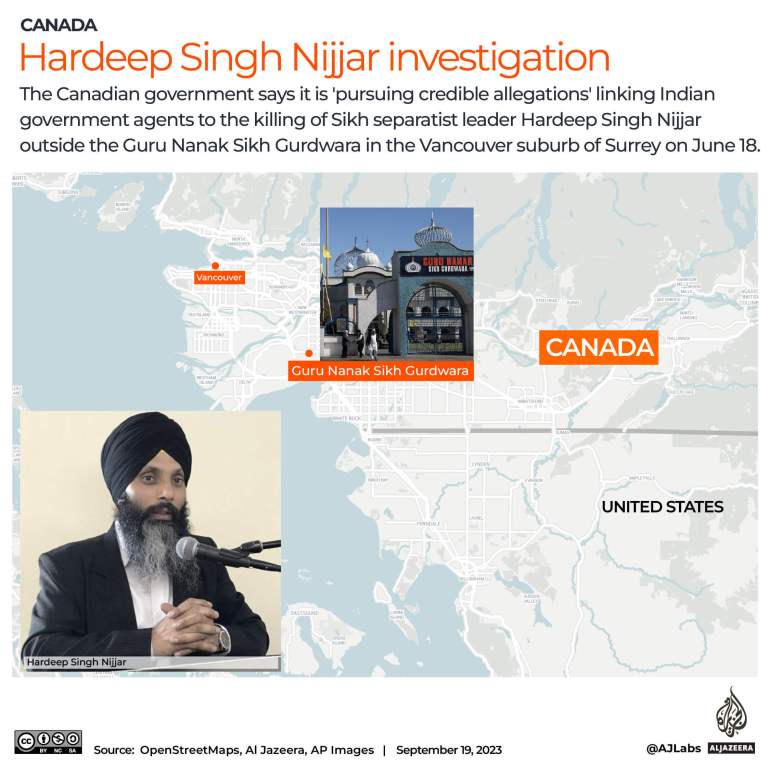
Avtar Singh Khanda
In June, Avtar Singh Khanda, 35, the alleged head of the Khalistan Liberation Force and aide to Amritpal Singh, died in the UK, following a diagnosis of terminal cancer. But the circumstances of his death were described as “mysterious”, with some attributing his demise to poisoning.
His funeral was attended by thousands. However, his mother and sister living in India were denied visas to attend the funeral by the UK Home Office.
Paramjit Singh Panjwar
Paramjit Singh Panjwar, 63, was the alleged head of the Khalistan Commando Force (KCF), a Sikh Khalistani armed organisation operating in Punjab.
Panjwar was gunned down in Lahore, Pakistan by two unidentified gunmen in May this year.
Panjwar played a significant role in the Sikh rebellion in India during the 1980s and 90s. He was known for his involvement in numerous acts of political violence, with the Indian government making extensive efforts to capture him.
Harmeet Singh
In January 2020, the alleged leader of the Khalistan Liberation Force (KLF), Harmeet Singh 38, was killed near Lahore, Pakistan.
He was succeeded by Avtar Singh Khanda, who took over as the KLF leader in 2020, according to reports. Singh was accused of murders in India and training fighters for the Khalistan movement.
How is the row affecting Canada-India relations?
Following Trudeau’s claims that India had a role in the killing of Nijjar, tensions between Canada and India have escalated.
India suspended issuing visas to Canadian citizens amid the escalation, citing “security threats” disrupting work at its missions in Canada. Also, in a tit-for-tat move, India expelled one of the top Canadian diplomats last week after Canada’s foreign minister expelled Pavan Kumar Rai, the most senior member of India’s foreign intelligence agency operating in Canada.
